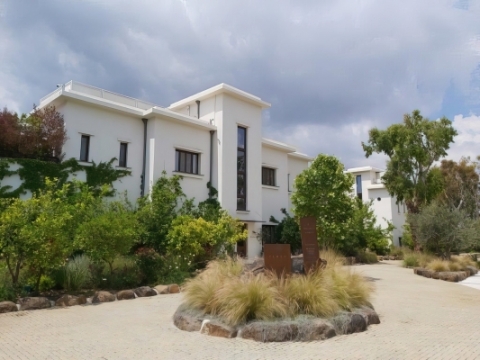Wild on the Golan Heights
Text & photos by Lydia Aisenberg
Merchants travelling to and fro between French controlled Syria and British Mandatory Palestine in the late 1920s to mid-1940s by way of the Golan Heights passed through a large French built customs post complex situated on the road ascending the lower approaches to the Golan – a short distance from the present day 1997-founded Israeli town of Katzrin.
With the French pulling out of that country in 1946, the crucially important mountain range was taken over by the Syrian Army. The Bauhaus architectural style customs house buildings, plus a number of smaller ones built from local black volcanic rock, became a heavily fortified base for that army, commanding an all-encompassing view and military advantage looming over a large portion of the Israeli, mainly agricultural, communities nestling below in the Hula Valley
The Syrians remained firmly ensconced at this crucially strategic and constant threat to Israel in this region until the Arab-Israeli war of 1967 when it was captured by the Israelis during ferocious fighting with heavy casualties suffered by both the Syrians and Israelis. And fighting occurred again in the 1973 Yom Kippur War when the Syrians unsuccessfully attempted to take back what had been lost just a few years before.
Following the Syrian-Israeli wars, and even though eerily empty, abandoned and slowly disintegrating, the eye-catching large buildings of the former French customs station sitting amongst the eucalyptus trees, black rocks and minefield warning signs, showed evidence of the Bauhaus simplistic, stylish use of rectangles, spheres and other geometric shapes. They stood out amongst the surrounding shrubs and greenery in a rather regal fashion, almost akin to a proud captain standing on the bridge and saluting as his ship went down into the depths below.
In recent times those same buildings, plus some new additions in the same style, have become an amazingly attractive and full of character boutique hotel and spa named Pereh, meaning wild in Hebrew.
For many years the former army command post was sometimes frequented by a unique herd of wild free-range cows left behind when local Syrian farmers fled during the heavy fighting in 1967. The cows however continuing to roam and graze on the rugged range during and after the Yom Kippur War six years later and are still around in present times although in much smaller numbers.
Not only cattle were left behind as the Syrians fled the Heights in 1967 but also large areas of unexploded landmines, most of which were marked-off by barbed wire fencing and yellow warning signs to this day. Until more recent times, landmines were also in the vicinity of the newly opened hotel and spa.
Since the development and opening of the Pereh Hotel a few years ago, apart from some small but to-scale models in glass showcases in the hotel lobby, there is little to no evidence of the aforementioned sights. The Bauhaus buildings have been incredibly – and totally gob-smacking to those who remember how they were until quite recent years – renovated in a multi-million-dollar development by Israeli businessman and former defense and security consultant, Leo Glazer.
The two main Bauhaus buildings now stand tall and proud, spruced up to the hilt as their magnificent features glint and seemingly wink in the sunshine, surrounded by attractive grounds, large swimming pool and the adjoining spa and, of course, the most breathtaking views over the valley below.
Another special feature in the hotel lobby is a heavily decorative two ton local basalt rock. The French built stone ceilings having been left more or less in their original state, giving an atmosphere of absolute authenticity together with the modern design and development.
At the side of the main Pereh wrought iron gates is a memorial site to Israel Defense Forces soldiers who served in the Golani Brigade and lost their lives on the 15th June, 1967 – the last day of the war.
The Golani soldiers were undertaking a search of Syrian army bunkers in the region when they tragically entered an area that had been heavily booby-trapped and in the ensuing explosions. Eleven of the soldiers lost their lives, 9 of whom are buried together at the Nahariya Military Cemetery.
As there was no special memorial site for the 11 young Golani fighters who lost their lives in the last hours of that war, Leo Glazer, working together with the families of the fallen soldiers and the I.D.F., created the memorial site alongside the grounds of the hotel with shaded areas for visitors to sit, read about those young men, about what happened, to contemplate and remember those who lost their lives serving their country.









Comments